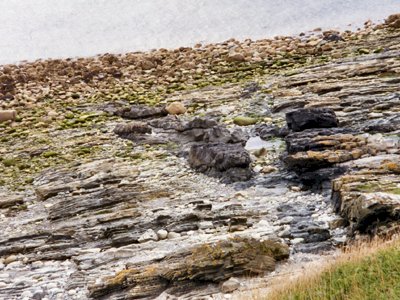Earth Science Conservation Review
| Mournes - Dunmore Head, Dykes Nos. 60, 61 & 63 | Down |
| Site Type: | Coastal section |
| Site Status: | ASSI |
| Council area: | Newry & Mourne District Council |
| Grid Reference: | J388247 |
| Google maps: | 54.15303,-5.87547 |
| Rocks | |
|---|---|
| Rock Age: | Tertiary (Eocene) |
| Rock Name: | Granite |
| Rock Type: | Andesite, Anorthosite, Basalt, Porphyry |
| Interest | |
| Other interest: | dyke, Intrusion |
Summary of site:
On the eastern and south eastern coastal flank of the Mourne Mountains, large numbers of dykes with predominant trends somewhat south of east cross the shore cutting through the local, slightly metamorphosed, Silurian sediments. These intrusions of once molten rock were mapped and numbered by Tomkeieff and Marshall in the early to mid 1930s. This stretch of coastline exposes three of them, dykes 60, 61 and 63.
Two of the dykes, numbers 60 and 63, contain rocks belonging to a group called andesites, fine grained rocks of intermediate composition (between granites and gabbros) with a little free quartz, a high proportion of plagioclase feldspar and some potassium feldspar. The andesites found here however are so distinctive that they are named from the locality and are described as being of the Dunmore type. They have a glassy groundmass containing many lath-like crystals of plagioclase up to 1.5 mm long. The molten rock also swept up fragments of another rock (xenoliths) with a mineralogy suggesting that it was silica-poor (i.e. basic û related to basalts). Dyke 63 also contains xenoliths of anorthite, an ultrabasic rock consisting almost entirely of plagioclase feldspar and rare outside the ancient basement rocks of the major continents.
Dyke 61 is composite (with more than one injection of molten rock), made up of basalt in contact with both walls, centrally injected by feldspar porphyry, the whole being 9.75 m thick. The basalt is dominated by hypersthene, a mineral belonging to a group called orthopyroxenes. The central intrusion contains well-formed crystals of plagioclase, up to 1 by 2 cm in size, in a fine groundmass. This dyke is cut across by another hypersthene basalt.
The association of intrusions of intermediate and basic rock types with the Mourne granites indicates complex processes operating in the molten rocks (magmas) deep below the granites. The mineralogy and xenoliths of these dykes indicate a slow-cooling basic magma at considerable depth with crystals and fragments mobilised in the injection phase of activity.
The site contains the best examples of composite dykes with these compositions to be seen anywhere along the coast. There are no threats to this short span of coastline.
Two of the dykes, numbers 60 and 63, contain rocks belonging to a group called andesites, fine grained rocks of intermediate composition (between granites and gabbros) with a little free quartz, a high proportion of plagioclase feldspar and some potassium feldspar. The andesites found here however are so distinctive that they are named from the locality and are described as being of the Dunmore type. They have a glassy groundmass containing many lath-like crystals of plagioclase up to 1.5 mm long. The molten rock also swept up fragments of another rock (xenoliths) with a mineralogy suggesting that it was silica-poor (i.e. basic û related to basalts). Dyke 63 also contains xenoliths of anorthite, an ultrabasic rock consisting almost entirely of plagioclase feldspar and rare outside the ancient basement rocks of the major continents.
Dyke 61 is composite (with more than one injection of molten rock), made up of basalt in contact with both walls, centrally injected by feldspar porphyry, the whole being 9.75 m thick. The basalt is dominated by hypersthene, a mineral belonging to a group called orthopyroxenes. The central intrusion contains well-formed crystals of plagioclase, up to 1 by 2 cm in size, in a fine groundmass. This dyke is cut across by another hypersthene basalt.
The association of intrusions of intermediate and basic rock types with the Mourne granites indicates complex processes operating in the molten rocks (magmas) deep below the granites. The mineralogy and xenoliths of these dykes indicate a slow-cooling basic magma at considerable depth with crystals and fragments mobilised in the injection phase of activity.
The site contains the best examples of composite dykes with these compositions to be seen anywhere along the coast. There are no threats to this short span of coastline.
| Enlander, I., Dempster, M. & Doughty, P., 2025. Mournes - Dunmore Head, Dykes Nos. 60, 61 & 63, County Down, site summary. [In] Earth Science Conservation Review. https://www.habitas.org.uk/escr/summary.php?item=1109. Accessed on 2025-04-03 |
| Previous Site | Next Site |

